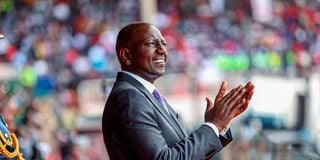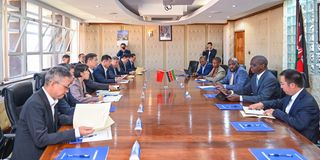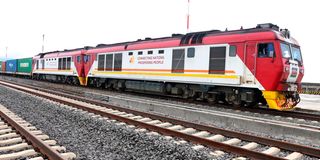Breaking News: Former Lugari MP Cyrus Jirongo dies in a road crash
Premium
On China trip, Ruto to test his economic diplomacy

President William Ruto.
President William Ruto arrived in Beijing on Sunday on his first trip to China that could test his pragmatism in foreign policy, placing his much-publicised Bottom-Up economic model to the biggest litmus examination yet.
The President will be among the guests in attendance to mark ten years of China’s Belt and Road Initiative (BRI), at a forum due on October 17-18.
It will be his first physical meeting with his Chinese counterpart Xi Jinping since he became head of state.
Mr Xi originated the BRI more than ten years ago to retool China’s inroads into marketplaces and sources of raw materials, by constructing roads, railways and ports with key trading partners across the globe.
In Africa, Kenya was among those who signed up on the BRI which now includes 46 African countries. Tanzania is the most recent signatory.
Yet that also marked the period Kenya amassed the most debt from China, for the money used to build roads and the Standard Gauge Railway, Lamu Port and other key projects that fit into the BRI.
Mr. Ruto has said in the past amassing debt isn’t his thing. However, the government also needs enough money to run operations and implement economic policies.
This kind of reality seems to have informed his pragmatism in foreign engagements, going by a recent policy bulletin seen by the Sunday Nation.
“The President’s Foreign Policy Doctrine is informed by the fact that despite initiating economic reforms and improving the various foreign direct investment (FDI) regulatory frameworks – aimed at encouraging commercial activities – Africa still lags (behind) other regions of the world when it comes to attraction and retention of FDI,” the bulletin says of Kenya’s Economic Diplomacy.
“Negative perceptions seem to harm the continent’s and the individual African countries’ ability to attract FDI, with two (2) fundamental challenges often cited by foreign investors; the issues of transport and logistics infrastructure, and the rule of law.” The bulletin adds that Nairobi will vigorously pursue more open borders, more trade as well as common pooling of infrastructure projects to develop regional blocs.
That is where China comes in. Last month, Transport Cabinet Secretary Kipchumba Murkomen toured China in what seemed like a reconnaissance trip. He met with Li Xiaopeng, Chinese Minister for Transport and Deng Li, the Vice Minister for Foreign Affairs of the People's Republic of China; Tan Wenhong, the Deputy Director General of China. The issue of infrastructure funding was discussed, though through a different model.
“Through our partnership, we hope to complete our ongoing road projects, extend the railway to Malaba, dual our main highways, expand our port and airports’ infrastructure, equip our Technical and Vocational Institutions, build water dams, implement our smart and intelligent traffic systems among others,” Murkomen said after the trip.
At the 2023 Global Sustainable Transport Forum, Murkomen told an audience of “opportunities available in Kenya for Public-Private Partnerships (PPP).”

Transport Cabinet Secretary Kipchumba Murkomen when he hosted a visiting delegation from China on October 8, 2023, at Transcom House, Nairobi.
The Chinese hadn’t tried PPP in Kenya, until the Expressway project, which seems to be working well. Now President Ruto has signed a law that could lure more Chinese investments into PPP-style projects, and change the way we calculate debt ceilings.
James Shikwati, an economist and founder of IREN-Kenya told the Sunday Nation the country must first tighten spending and put money in productive sectors.
“Extra borrowing without sealing leakages through corruption, destroying productivity through hostile taxes and public policy is not advisable and is ill-informed,” he told the Sunday Nation.
Citing pressure from the International Monetary Fund, Shikwati said the best strategy for Kenya is to develop diversification to help stay debt secure and avoid being pushed by the multilateral lender.
“I think when it comes to China...they have to simply align to Chinese broader objectives. And showcase their maturity to ride the rough multipolar waves. So far we do not have that spine. However, possible that China can dust off the original east Africa rail and road plans of the 2010s and gift Kenya something.
The Public Finance Management (Amendment) Act means the threshold of borrowing is set at 55 per cent of the Gross Domestic Product (GDP) in present value terms, a departure from the current numerical debt ceiling with a percentage of debt to the GDP. The initial limit was set at Sh10 trillion.
“It means the Government may now exceed the threshold — by not more than five per cent — in times of extreme economic circumstances,” State House said on Friday.
The Cabinet Secretary for Treasury is, within five years, expected to gradually reduce public debt to sustainable levels in line with the set debt threshold.
State House says this will also protect infrastructure spending to ensure Kenya’s long-term development and economic prospects are preserved.
Dr Samuel Nyandemo, senior lecturer at the University of Nairobi School of Economics said the new law will allow the government to borrow with respect to the county's economic strength thus controlling the government's appetite of borrowing.
“More importantly, this shall bring in a new dimension of more private public participation which is a good practice,” he argued.
PPP means the government can bring in a contractor who seeks funding to develop a project and can charge users a fee to recoup the money. The Nairobi Expressway, for instance, was developed by the China Road and Bridge Corp and has since been charging motorists a specific tariff to use the road. One other road eyed for PPP, officials say, is the Nakuru Mau Summit highway, which is then expected to link up to the highway to Malaba.
The government is also seeking financiers to extend the SGR to Malaba. In August, Kenya and Uganda signed an MoU to jointly seek funding for the SGR.

An SGR train at the Naivasha Inland Container Depot on January 17, 2022.. The government’s determination to extend the SGR line to Kisumu, Malaba, and Isiolo at a cost of Sh2.1 trillion has captured the attention of local and global observers.
But economists say the new threshold for borrowing isn’t the key out of jail.
“Setting the borrowing limit as a percentage of GDP means you have to grow the economy to raise more debt. A great idea if the government does not keep raising the ceiling as it used to with the old limits,” Prof XN Iraki of the Faculty of Business and Management Sciences, University of Nairobi, told Sunday Nation.
PPP, he argued, could help the government keep the debt-to-GDP ratio within the legal limit or continue raising more taxes. Some economists argue that the government calculations of debt routinely ignore what counties owe contractors, even though counties rely on the Treasury to repay.
A better ratio, argued Ken Gichinga, an economist in Nairobi, is to use the ratio of debt service to tax revenue which he says is more precise and easier to track.
“I also don't feel it will reduce the government's appetite for debt. If anything the debt projections in the latest Budget Review and Outlook Paper point to an increasing appetite for debt,” Gichinga said.






